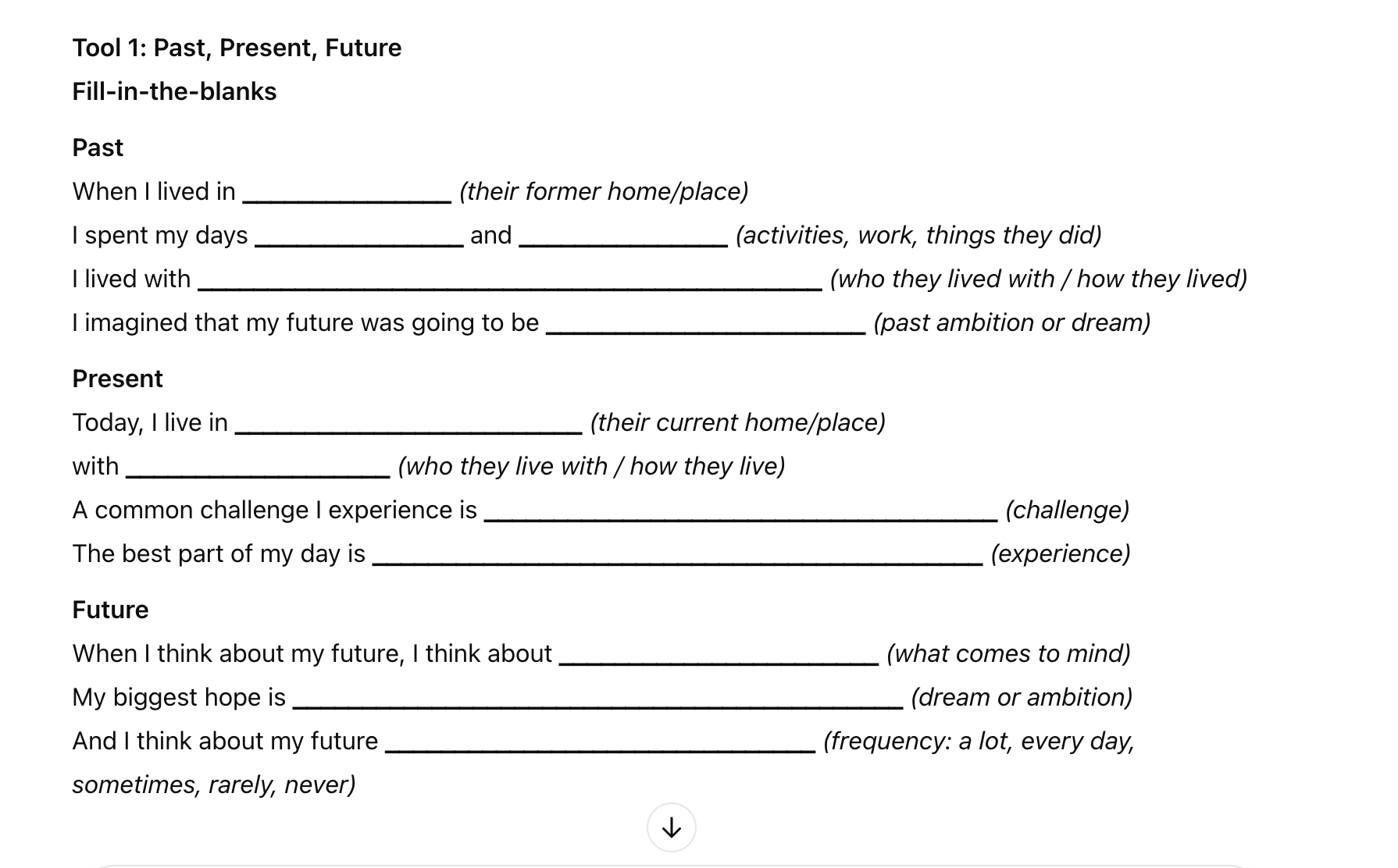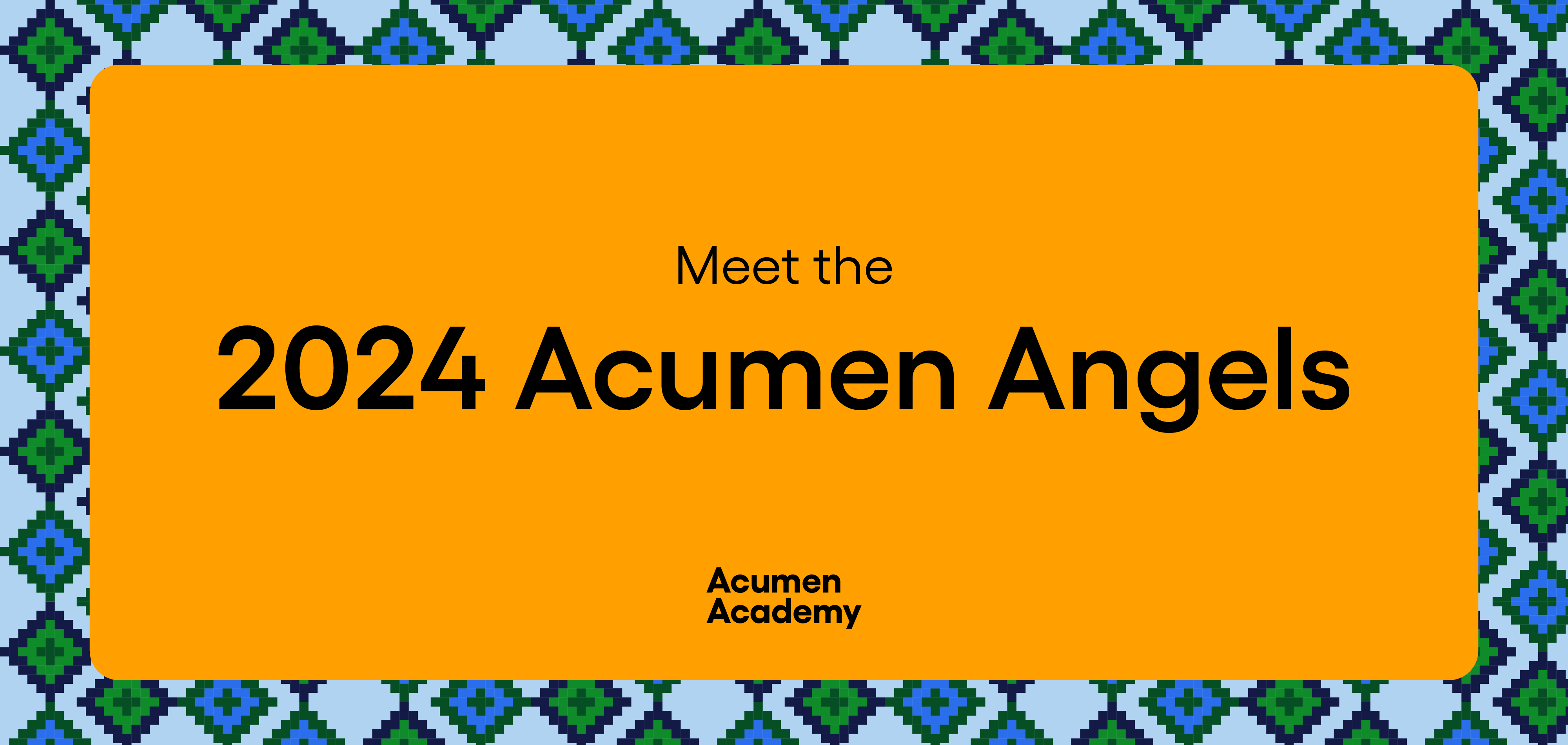Leadership
Co-create for dignity and impact
3 tools to deepen your understanding of customers and ensure customer insights guide decisions
June 10, 2025
Jocelyn Wyatt is an Acumen Fellow and the CEO of Alight, an organization that co-creates with displaced communities to build lives of dignity, joy, and connection. With a deeply human-centered approach, Jocelyn leads efforts to center the voices of those most affected.
Below, the Alight team shares three tools they use to help you deepen your understanding of customers and co-create solutions grounded in their insights and lived experience.
Read below to learn more
Whether working in the tech industry or humanitarian aid, we know it’s important to “know your customer.” But too often, we focus on getting to know our customers only through the lens of the specific thing we’re designing for, or the specific problem we’re trying to solve.
At Alight, we believe that all humans are whole, complex, and worthy of truly being seen. And we believe that people are so much more than the current context or situation they find themselves in. Each person carries with them a past, and has hopes and dreams for their future. To really know and understand our customers, we need to embrace their entire journey: past, present, and future.
When we understand, acknowledge, and honor the complexity within our customers, we are better able to co-create with them and design human-centered, desirable, and sustainable solutions.
By prioritizing co-creation, social entrepreneurs can not only address immediate needs but also build resilience and promote long-term development within the communities they seek to serve.
A co-creation strategy is rooted in several key principles:
- Dignity and ownership: By collaborating directly with customers, we can ensure solutions are tailored to the community's unique needs and aspirations. This fosters a sense of ownership and dignity among community members.
- Sustainability and self-reliance: Co-created initiatives are more likely to be sustainable, as they are developed with insights from those who maintain them. In DRC, by turning “aid recipients” into customers, a co-created initiative called Asili has allowed us to develop a radically new level of quality for water and healthcare, while still allowing access for everyone, all while being self-sustaining and community-run.
- Enhanced engagement and relevance: Engaging communities in the design process leads to products and services that are more relevant and widely accepted. In Uganda, Alight revitalized a women's center by implementing community-driven ideas, such as creating a netball court, which increased participation and fostered a sense of belonging.
Start today
Here are three tools that Alight uses to better understand customers, their journeys, and their complexities.
- Past, Present, Future Fill-in-the-blank
- Observation – I notice, I wonder
- Essential Human Experiences Card Sort
Tips for engaging customers:
When using any of the following tools, keep in mind these recommendations for engaging customers:
- Meet in a space where customers feel comfortable.
- Participation is 100% voluntary, they can respond however they like. There’s no right or wrong direction — follow their lead.
- Don’t probe or push them to respond in a certain way.
- Be aware of your power. The goal is open dialogue. But stay mindful of dynamics at play at all times.
- Thank them. Compensation for their time is always appreciated.
- Avoid retraumatizing vulnerable individuals. When possible, speak with someone you already know or bridge the relationship with a trusted third-party.
- Communicate ahead of time what to expect, and how you’ll use the information shared.
Tool 1: Past, Present, Future
Fill-in-the-blanks
.png)

How to use the tool:
- Arrange a meeting with a customer in a space where they feel comfortable.
- Use the tool as a prompt to guide the customer in speaking about their past, present, and future.
- Take notes to fill in the blanks.
- After the conversation, jot down additional notes and observations. What stood out to you? How was the customer’s energy throughout? What might that tell you about the answers they shared?
- Repeat with a handful of customers.
Use this tool if:
- You are new to interviews. This is a nice place to start. There’s structure built in, but also flexibility to dive deeper depending on your comfort level or the flow of the conversation.
- You want to more deeply connect with someone in an accessible way. This tool is a great conversation starter, with many follow-up opportunities based on the answers shared.
- You need to uncover clear differences across customers. The introductory and templated style of this tool makes it easier to compare how different people respond and to identify patterns.
What insights from this tool can be used for:
Making space to explore customers’ past, present, and future helps you understand their journey — sometimes even visually. You’ll see how a customer maps their lived experiences and desired or understood trajectory, which can inform how your designs fit within that journey and what role they might play.
When we know a person or community through a more storied lens, we’re better equipped to identify the pain points that shape decisions and behavior because we better understand the past they carry, the present they navigate, and the future they envision.

A woman in Uganda shares her journey of rebuilding her life in a new country.
Tool 2: Observation - I notice, I wonder
Observe your customers
Observation is a powerful tool for collecting, hearing, and seeing our customers — and for gathering insights that inform our choices and designs. This observation tool is largely inspired by the IDEO.org Travel Pack and the activity “I notice, I wonder.”
How to use the tool:
- Select a place where your customer spends time (e.g., their home, church, clinic, playground, or market).
- Take 30 minutes to sit silently and observe. Focus your visual attention on one spot at a time and pay attention to the details. How are people interacting? How do they look? What expressions are they making? Notice facial expressions, gestures, and other nonverbal cues.
- Jot down what you see — your observations. Each observation should start with the words “I notice….”
- Next, write down a question, thought, or curiosity that arises from each observation, beginning with: “I wonder…”
Use this tool if:
- You want to reach a deep level of empathy, quickly. Immersing yourself in a customer’s environment, without the pressure to converse or interact, allows for a powerful “walk-a-mile-in-their-shoes” experience that’s often memorable and transformational.
- You need to validate (or invalidate) your assumptions. Observation quickly reveals what you were right about and what you may have misunderstood.
- You are seeking to understand human behaviors or patterns. Taking time to fully absorb a space (through sight, sound, smell, and feeling) helps you to notice nuances and the subtleties of daily life: how people move, their energy, and the rhythms of their routines.
- You need to generate questions. Turning your observations into “I wonder…” statements activates your curiosity. You’ll walk away with dozens of follow-up questions to explore through, conversation, research, or reflection.
What insights from this tool can be used for:
Better understanding your customer’s behavior, environment, and social experiences can help uncover truths you may not have thought to ask about. Observation brings to light the unsaid. These insights can inform design guidelines, influence the direction of a project, or highlight challenges that must be addressed for your work to succeed.
Tool 3: Essential Human Experiences Card Sort
Ask your customer to sort the cards 
To serve communities on their journeys, we must think beyond basic needs and design programs and services that address the long-term needs that are essential for a fulfilling life. At Alight, our programs are built around 6 Essential Human Experiences that provide a holistic view of our customer's journeys.
Use the cards to engage in conversation about how customers value and prioritize the different experiences. Meet in a space where they feel comfortable. Bring this deck of cards and a notepad to take notes.
Here are options for how you can use the Card Sort. Ask customers to sort the cards from most important to least important, and explain their choices.
- Ask: If they could only have one, which would it be and why? What might they have selected 5 years ago, and why? What do they think they might select 5 years from now?
- Ask: Is there an Essential Human Experience missing? If so, what might that be?
Questioning the relevancy of these 6 Essential Human Experiences in the problem you’re trying to solve? Don’t worry! You can use this approach with any set of cards so feel free to create your own version related to your specific customer group and intervention.

A team of humanitarians gathers to reflect on what they learned about Loving Human Connection (one of the 6 Essential Human Experiences) after guided conversations with community members.
Use this tool if:
- You want a more inclusive, lower-barrier approach. The visual nature of this tool requires minimal (or no words) to be used. This makes it accessible for communities who may not read, prefer another language, or communicate in other ways. It’s flexible and approachable; meeting people where they are, and building comfort and trust from the start.
- You need a good conversation starter. The adaptability of this tool allows you to lean into wherever the customer is taking the conversation, helping you to go deeper in a seamless, natural way.
- You seek to understand someone’s approach to choice and prioritization. Asking customers to rank or choose from a set of options reveals how they approach decisions and what matters most to them.
- You want a quick, scenario-based conversation. You can easily layer on different contexts. For example: How might you rank these if you had unlimited money? If you lived in a different country? How might your mother rank them differently than you?
What insights from this tool can be used for:
When we know what matters most to people, we gain insight into what drives and motivates them, and what they’re willing to give their time, energy, and resources to.
Synthesize insights
Synthesis is an important step for drawing out insights. There are many ways to do this, but one prompt we’ve found useful at Alight is:
After using these tools to understand your customer, what’s one thing you heard or learned that you wish everyone in your organization or company understood about your customer?
Using insights to co-create
It’s great to have insights. But to make them effective, you have to use them in a way that shares power with customers and makes space for them to influence, guide, and point the way forward. That’s when true co-creation happens.
Here are ways to apply customer insights:
- Ask different strategic questions. After gathering insights from Ukrainians living in Poland and Ukraine 3 years into the war, our strategic question changed from our earlier emergency response question of: How might we help new arrivals navigate and explore their options with clarity and dignity? With deeper understanding, our question became: How might we co-create with displaced Ukrainians and their home communities to stay strong along their journey to recover the peace of home?
- Shift your focus area to better align with your customers’ reality. You may discover that the thing you’re trying to solve could actually be addressed by solving a different problem. For example, our initial assessments with Afghan women who recently arrived in the United States, found that they desire the opportunity to learn a new skill that could be used in the job market. But, through deeper insight work and the use of these tools, we discovered a root issue these women were facing: isolation and depression. In response, we designed a program that would not just train them in a skill, but an experience that enabled for more connection with other Afghan women. After participating, reported rates of depression and isolation dropped significantly.
- Change how you engage with your customer moving forward. Our Protection Technical Lead used to hold sessions with customers at a centralized refugee camp location. One day, someone he expected to be there wasn’t, so he visited their home within the camp. What he learned and discovered from that visit was more than he could have uncovered in numerous sessions at the centralized location. Since then, he’s made it a practice to meet people where they are.
- Adjust who you engage, when, and how. These tools help us identify who the influential community leaders are. Not just the people one would initially identify as a community leader, but those who may have a quieter, less obvious sphere of power and influence. We’ve learned to actively engage less visible but deeply influential individuals (e.g., small business owners, religious leaders, and community-based organizations) to boost project desirability, community buy-in, and sustainability.
- Use your influence to make different choices and decisions around investment (time, resources, money, attention). In Somalia, insight work with a nomadic community facing repeated climate displacement led to a major shift. The community told us: “We’re fed up with the constant move. I want to start fresh and have a place to call home.” We co-created a new model of climate-responsive resettlement with the community, the mayor, public and private partners, and local residents. We reimagined what a current resettlement could look like, one that could fulfill their dreams of providing a brighter future for their children — with education, healthcare, and job opportunities rather than using our resources and grant funding to offer livestock or agricultural training.
- Let your heart and gut lead. When you deepen your understanding of your customer, their stories stay with you. It weighs on you, in a good way. If something feels “off” in a design, or you’re stuck between two ideas and one is calling out to you — trust that. Return to your notes. There’s likely data that backs up the truth you feel. Use that to advocate for what your customers truly need and make their voices visible.
Now, let’s co-create!
Alight
Alight’s mission is to build a meaningful life for and with the displaced. This means not simply addressing basic needs, but building lives filled with joy, dignity, and connection. Alight takes a collaborative, human-centered approach. Unlike traditional humanitarian aid, we co-create solutions hand in hand with displaced communities, who know best what they need. Alight’s CEO, Jocelyn Wyatt, is an Acumen Fellow.

-2.jpeg)

.jpeg)